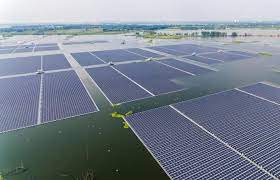A notable case study for floating solar energy can be found in the development of the “Yamakura Dam” floating solar power plant in Japan. This project, completed in 2016, is one of the largest floating solar installations in the world and serves as an excellent example of the benefits and challenges associated with this innovative renewable energy approach.
Project Name: Yamakura Dam Floating Solar Power Plant
Location: Chiba Prefecture, Japan
Key Details:
- Capacity: The Yamakura Dam Floating Solar Power Plant has a total capacity of approximately 13.7 megawatts (MW), generated by more than 50,000 solar panels mounted on floating platforms.
- Floating Platform: The solar panels are mounted on floating platforms made of high-density polyethylene (HDPE) that are designed to be both durable and resistant to corrosion. The platforms are anchored to the bottom of the dam.
- Water Reservoir: The solar installation is located on the Yamakura Dam’s reservoir, which is used to store water for irrigation and flood control.
Benefits:
- Maximized Land Use: Floating solar panels take advantage of otherwise unused bodies of water, making efficient use of space and reducing land requirements. This is especially important in densely populated areas like Japan.
- Water Conservation: By covering the dam’s reservoir with solar panels, the project helps reduce evaporation, conserving water resources.
- Clean Energy Generation: The floating solar power plant generates renewable energy, reducing the reliance on fossil fuels and lowering greenhouse gas emissions.
- Increased Efficiency: Water-cooling effect: The water beneath the panels helps cool them, which can increase the overall efficiency of the solar panels.
Challenges:
- Maintenance: Accessing and maintaining the solar panels on water can be more challenging than traditional land-based installations. Specialized equipment and procedures are needed.
- Environmental Impact: Proper environmental assessments are necessary to ensure that the project doesn’t harm aquatic ecosystems or interfere with local wildlife.
- Installation Costs: The initial investment in floating solar can be higher than ground-based solar due to the cost of materials, anchoring systems, and installation.
- Water Quality: Care must be taken to monitor and maintain water quality to prevent algae growth or other issues that could affect the integrity of the panels.
The Yamakura Dam Floating Solar Power Plant has been a success in Japan, demonstrating the feasibility and advantages of floating solar installations. It has also inspired similar projects in other parts of the world, particularly in regions with limited available land for solar energy development. Floating solar provides a promising avenue for expanding renewable energy capacity while making efficient use of water resources.



